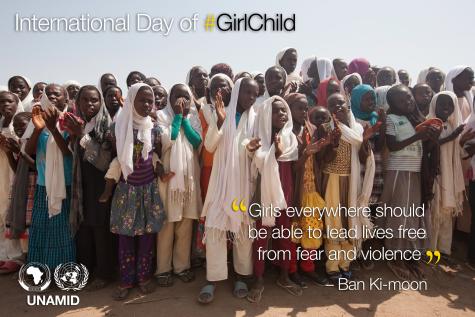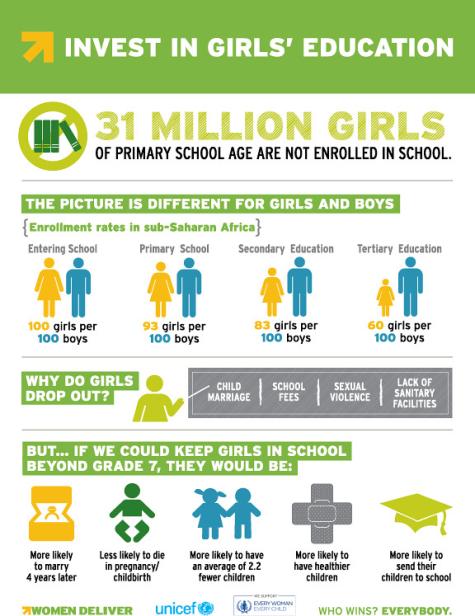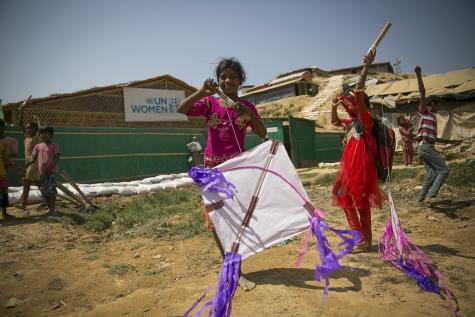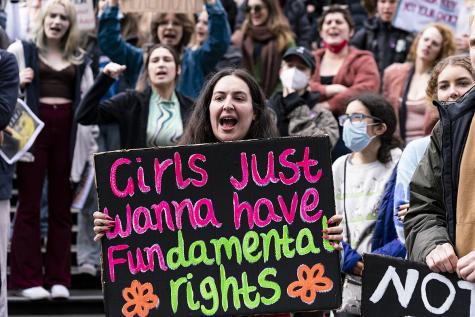International Day of the Girl - October 11

➡️ INTERNATIONAL DAY OF THE GIRL - October 11
Girls' Rights are Human Rights!
International Day of the Girl is an annual global initiative celebrated by the United Nations since 2012. The day is dedicated to championing the rights and potential of girls everywhere.
This year marks thirty years since the signing of the Beijing Declaration, the most progressive blueprint ever for advancing women's and girls' rights. Since then, progress has been made in education, health, and rights, but many inequalities remain.
The 2025 theme, 'The girl I am, the change I lead: Girls on the frontlines of crisis', highlights the extreme challenges that girls growing up amid war, climate change, poverty, and other crises face. Crises exacerbate stubborn inequalities and create extra barriers which prevent girls from achieving their full potential.
Jump straight to our resources on ➡️ International Day of the Girl
Explore our comprehensive guides on -
-
The Sustainable Development Goals (SDGs)
Please share this powerful resource on Twitter, Bluesky, Instagram, Facebook, and LinkedIn ;-)
*****

The State of Girls' Rights
Sustainable Development Goal 5 focuses on achieving real, long-lasting gender equality. In 2023, a United Nations report revealed that Goal 5, like many of the other goals, is falling short of almost all its targets.
The world is failing women and girls.
-
More than 340 million women and girls will still live in extreme poverty by 2030.
-
Worldwide, 119 million girls are out of school. In countries affected by conflict, girls are twice as likely to be out of school as those living in countries at peace.
-
More than 575 million girls live in countries where discriminatory gender norms contribute to violations of their rights, including female genital mutilation (FGM), child marriage, dowries, and societal expectations such as defining the role of girls and women as mothers, wives, and care providers.
-
More than 230 million girls and women alive today have undergone FGM in 30 countries in Africa, the Middle East and Asia. FGM is a serious violation of human rights.
-
Globally, 1 in 5 women is married before their 18th birthday.
-
One in three women and girls worldwide has experienced physical and/or sexual violence in their lifetime.
-
There are an estimated 21 million adolescent pregnancies among girls aged 15–19 every year. An additional half a million pregnancies occur annually among even younger girls aged 10–14.
-
More than 8,000 women die as a result of India's dowry system every year.
-
In the last 2 decades, self-harm has been a leading cause of death among adolescent girls.
Crisis, conflict and displacement all dramatically increase the risks of child marriage, violence, and maternal mortality for girls. To achieve gender equality and the empowerment of women and girls by 2030, an additional $360 billion in annual investment is needed.

The Girl I am, the Change I Lead – 2025 Theme
The planet is facing a polycrisis made up of unprecedented levels of war and conflict, massive displacement, soaring levels of food insecurity, the devastating consequences of the climate crisis, slashes to foreign aid funding, the threat of the next pandemic, political polarisation and democratic erosion, and unrelenting inflation.
These threats affect everyone, but young people and especially girls are the most vulnerable and suffer the consequences for the longest.
In times of conflict, girls always suffer the hardest. Child marriage rates double, and the risks of sexual violence, teenage pregnancy, and maternal mortality rocket – all with little or no support for survivors.
In 2023, over 170 armed conflicts were recorded, 612 million women and girls lived within 50km of these conflicts - a 50% increase in the last 10 years.
It has been proven that if girls thrive, we all thrive. This year's theme calls for the recognition of girls' leadership in times of crisis. Women's and girls' voices often go unheard, and this year aims to change that by not only listening but putting words into action.
Girls are stepping up in the face of today's challenges; they are organising, fighting for justice, and demanding an end to violence and the cycle of poverty.

Girls' Rights for a Better World
The challenges that girls face simply because of their age and gender mean that we have to push even harder to increase awareness of gender inequality and the adversities girls face as a result of humanitarian crises.
International Day of the Girl recognises that these issues persist year-round, but this day draws global attention to their plight, sparks conversations, and encourages policy change. By prioritising the needs and opportunities of every girl, we can help to build a more just and prosperous future for everyone.
Advocating for girls' rights is not just an investment in their future, but in the future of humanity.
Author: Rachael Mellor, 10.10.25 licensed under CC BY-SA 4.0
For further reading on International Day of the Girl see below ⬇️
- International Day of the Girl Child - UN128213
- International Day of the Girl - PLAN309452
- International Day of the Girl: Stand Up For Girls' Education - Care128214
- UNICEF - International Day of the Girl 2022309506
- UNESCO - International Day of the Girl Child257785
- UN Women309509
- Action Aid309508
- Plan International309507
- End Violence Against Children309512
- October 11 is Day of the Girl - Plan International128219
- Day of the Girl - Virtual Summit128220
- Our Instagram REEL on the topic309630
- Because I am a Girl - Plan Canada128221
- Because I am a Girl (Plan) - Facebook128222
- Because I am a Girl - Plan128223
- Because I am a Girl - YouTube128233
- Because I am a Girl (Plan) - Playlist128234
- Popular International Day of the Girl Child Videos128235
- Wikipedia128231
- @PlanGlobal128226
- #IDG2025492414
- #IDG2024434874
- #WorldGirlsDay309503
- #ChangeTheCompliment492413
- #Girlstakeover492416
- #EmpowerGirls434873
- #UntilWeAreAllEqual492417
- #girlchildday434871
- #DayOfTheGirl128224
- #GirlsDay128225
- #DayOfTheGirl309505
- #GirlsGetLoud309501
- #ItsAGirlThing128227
- #BrighterFuture128228
- #BIAAG - Because I am a Girl128230
- #bcimagirl128229
- YouTube128232
- Google Images128236
- Google News128211
- Google Search128237
- International Day of the Girl 2025 - The girl I am, the change I lead: Girls on the frontlines of crisis - UNICEF 492404
- Girls Pay the Price As Aid Cuts Hit Countries with Deepest Gender Inequality - Save the Children 11.10.25492845
- International Day of the Girl: UNICEF Continue to Promote Girls in Science - UNICEF 10.10.25492843
- Girls' Speak Out - 2025 International Day of the Girl - UN 10.10.25492842
- Bold, diverse and unstoppable: Girls speak out amid a world in crisis - UN Geneva 10.10.25492846
- International Day of the Girl 2025: “If we take care of the earth, the earth will take care of us.” - Care 10.10.25492844
- New global report warns child marriage is evolving in 2025 - Global Newswire 08.10.25492411
- Dove Marks International Day of the Girl With a Call to #ChangeTheCompliment - Business Wire 08.10.25492408
- Shero’s Rise Hosts Empowerment Summit for LA Girls Ahead of International Day of the Girl - WGNO 07.10.25492412
- Everything She Can Be: Honoring the Power of Girls Everywhere - U.S. Committee for Refugees & Immigrants 07.10.25492409
- Publication: Girl Goals: What Has Changed for Girls? Adolescent girls’ rights over 30 Years - UNICEF 06.03.25492405
- Tweet: Girls are powerful agents of change! On this International Day of the Girl, we commit to amplifying their voices in the pursuit of sustainable development. - @UNFPAEth…434872
- Video: International Day of the Girl - SavetheChildren NZ 09.10.24434869
- Tweet: To mark the International Day of the Girl Child, @Atayeshe along with PioSmith_UN, @UNFPAAsiaPac Regional Director and @DiagneAndrea , @UNFPAIndia Representative joine…434870
- International Day of the Girl: Girls’ rights and vision for the future - UN Women 08.10.24434867
- Just a girl, changing the world on International Day of the Girl 2024 - Care 05.10.24434868
- Millions of Girls Abused in the Name of Toxic Masculinity - Global Issues 13.10.22310782
- The Girl Child Is Still Under Threat Globally - Forbes 09.10.22309510
- Letter to the editor: Zonta continues to support women, girls - Post Star 09.10.22309513
- 5 Films To Watch On This International Day Of The Girl Child 08.10.22309451
- Girls and young women shut out and silenced when participating in politics – global survey - Relief Web 05.10.22309511
- Report: Adolescent Girls Programme Strategy, 2022 - 2025 - UNICEF492407
- Day of the Girl is critical, but support is needed year-round, say campaigners - Guardian 11.10.21257692
- Participate in a women’s leadership mentoring programme in Nepal - Gov.uk 11.10.21257676
- UN Women - In Focus: International Day of the Girl 2021257784
- It's A Girl Thing (2014)128238
- It's A Girl Thing | #itsaGirlThing (2014)128239
- The State of the World’s Girls 2014: Pathways to Power: Creating Sustainable Change for Adolescent Girls128216
- The Other Malalas (2013)128240
- International Day of the Girl (2013)128241
- International Day of the Girl Child 2013: Innovating for girls' education128242
- Today, A Promise to Girls - by Desmond Tutu and Ela Bhatt 10/12128215
- UN (finally) Recognizes International Day of the Girl Child: 'Let Girls Be Girls, Not Brides' 10/12128217
- A much needed International Day of the Girl - Al Jazeera 10/12128218
- Plan Asia celebrates International Day of the Girl (2012)128243
- Message by Her Majesty Queen Rania Al Abdulla (2012)128244
- International Day of the Girl: Fulfill girls' potential; end child marriage (2012)128245
- Day of the Girl (US) - Archive128212
- Our TWEET - please share309633
- Our FACEBOOK post - please share309631
- Our INSTAGRAM post - please share309632